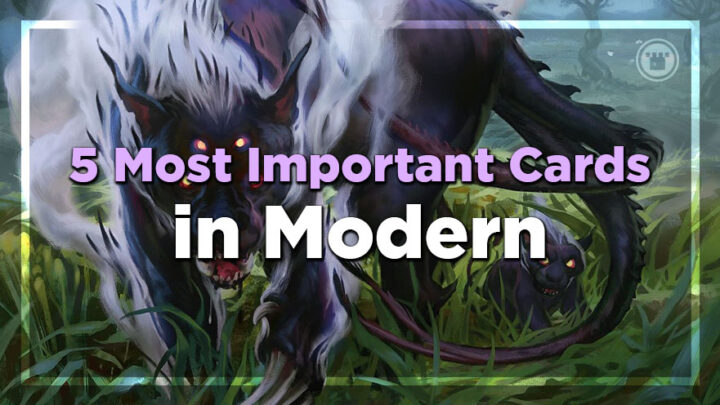Modern has 16,117 legal cards ranging from 8th Edition to Innistrad: Crimson Vow. In a card pool this wide, it’s natural for there to be a rather large gap between the best and the worst cards. Once we narrow our focus on cards with competitive viability, the card pool shrinks dramatically. However, there is still a stark difference between the best and worst competitive cards.
Identifying the important cards in Modern will help determine not which decks are best, but what decks are allowed to do in a competitive realm. There are many ways we could quantify the five most important spells in Modern, but my criteria are simple: Which spells put the most restrictions on the format? After all, what a deck can do in a vacuum is very different from what a deck is allowed to do within a metagame.
Lurrus of the Dream-Den
If you play competitive Modern, you’ve almost assuredly run into my favorite Nightmare Cat. Lurrus receives polarized reactions from the community, having both loyal supporters and detractors. Grixis Death’s Shadow, Hammer Time, and Jund Saga are the most notable decks that choose Lurrus as a companion, though there are more that get access for little or no cost.
So, why is Lurrus important? Simply put, Lurrus makes it difficult to play a value-oriented game in Modern unless you have a Lurrus of your own. The companion mechanic requires you to give up a sideboard slot and meet a deck building condition, and in return, you get access to an additional card during all your games. This puts Lurrus decks up a card over decks without companions as soon as the game starts. The floor of Lurrus is often casting a Mishra’s Bauble from the graveyard, which is at least another free card. However, if Lurrus starts buying back Ragavan, or other threats, or sticks around for multiple turns, that two-card advantage spirals out of control quickly.
The best ways to beat Lurrus decks are to go under them with a deck like Burn or Prowess. These decks make it difficult for opponents to pay the three mana to put Lurrus in their hand without losing the board. Going over Lurrus is another viable strategy, which we see in decks like Tron. Finally, playing a deck that doesn’t care about being down a few cards will also be effective. Decks that win with single cards, like Belcher and Living End, are great examples.
Ragavan, Nimble Pilferer
Ragavan, Nimble Pilferer is undeniably a Modern all-star that has undeniably shaped how decks are built. Since Modern Horizons 2, red decks have had the pleasure of dashing our friendly neighborhood Monkey Pirate. This has been a boon for red midrange decks, as Ragavan allows them to take a proactive approach, which had been difficult previously. Ragavan may look like an aggressive creature, and to a degree it is, but in the scope of Modern, it plays far better as a value creature. In my mind, Ragavan plays more like Deathrite Shaman than Goblin Guide.
However, there is one rule that applies to both red one-drops: If either of them hits you twice, you’re likely dead. Now, you’re not dead for the same reason – Ragavan decks care much more about two extra mana and the potential for extra cards than four damage. But, in its own way, Ragavan makes it hard to sit around. You need to be able to either kill Ragavan early, or be able to put enough creatures in play to block it. Decks that excel at these two things are Grixis Death’s Shadow, Izzet Murktide, Jund Saga, Hammer Time, and Yawgmoth. Grixis, Izzet, and Jund all have plenty of early removal spells, while Hammer and Yawgmoth both have enough cheap blockers to get in the way.
Solitude
Solitude was met with mixed reviews during preview season, but once players started pairing it with Ephemerate and Yorion, it became ubiquitous. Deck builders tried Solitude in nearly every deck that could support it, and it eventually found homes Azorius Control, Four-Color Blink, and Elementals.
Solitude has since become the strongest litmus test for creatures in Modern. If you’re looking to play a creature-based deck, you’d better have creatures with ETB effects, plenty of disruption, or enough creatures to outpace it. Hammer Time, Humans, and Grixis Death’s Shadow are among the best weapons against Solitude, while decks with low creature counts (like Azorius Control and Burn) are good places to be, too.
Prismatic Ending
Prismatic Ending is perhaps the removal spell that white decks have been waiting for. No longer are white decks beholden to Path to Exile; Prismatic Ending cleans up a large number of creatures in Modern, as well as nearly all the good noncreature permanents.
Prismatic Ending mostly shows up in Azorius Control, Hammer Time, and Four-Color Blink, and it often gets splashed in a handful of other decks. The strength of this card is that it makes noncreature permanents much more vulnerable than they were before. Chalice of the Void, Rest in Peace, Blood Moon, and Heliod, Sun-Crowned are now significantly easier to answer in game one. It’s also just good against creature decks as well, which is a rarity for cards that deal with artifacts, enchantments, and planeswalkers.
Prismatic Ending makes it risky to play small permanents, but permanents that add value the turn they come into play will put it in an awkward position. (Teferi, Time Raveler is a great example.) Cheap permanents that have high converted mana values, like Murktide Regent, also get around Prismatic Ending nicely. Enter the battlefield abilities are also strong against Prismatic Ending, which makes Omnath and friends especially strong.
Omnath, Locus of Creation
Speaking of which, Omnath certainly isn’t a new face when it comes to Modern. Since its release in Zendikar Rising, it’s become a common finisher for midrange and control decks (such as Four-Color Blink and Elementals).
Omnath is possibly the single strongest value card in Modern, full stop. Drawing a card when it enters the battlefield makes removal less valuable, however it demands an answer. Omnath with a fetch land can gain four life on consecutive turns making racing extremely difficult. A fetch land also has the ability to generate five mana, which leads to explosive turns early enough in the game to rival Tron.
So, how do we beat Omnath? Just like when facing Ragavan, you can’t wait around – you need a plan to end the game. And as when playing against Lurrus, you can choose to go under or over Omnath, but you need to turn up the dial in either direction. Hammer Time, Boros Prowess and Belcher are easy ways to go under Omnath. Tron is the best way to go over Omnath, and likely one of the few strategies that can at the moment.
By identifying the best spells in Modern, we can get a clearer picture of what the best decks are and what makes them so strong. It also makes it easier to exploit these decks’ weaknesses and predict how the metagame may shift in the coming weeks. As always, I’m available on Twitter at @RappaciousOne for questions and comments. I’ll see everyone next week!

Michael Rapp is a Modern specialist who favors Thoughtseize decks. Magic sates his desire for competition and constant improvement.

